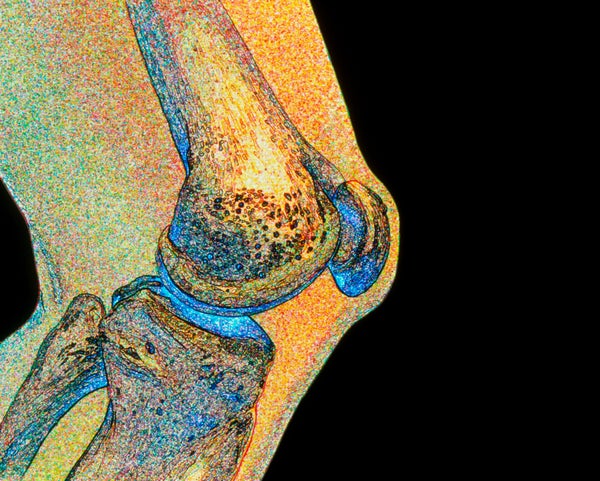A complex cascade of biochemical signals determines what we eat, when we eat and how much we eat. Our digestive tracts and fat cells are known to secrete hormones that drive our hunger levels and our sense of satisfaction after eating. Now a new player has come to the table, our bones.
A paper published this March in Nature shows bone cells secrete a hormone called lipocalin 2—and it has a surprising effect in mouse experiments of reducing appetite and stabilizing blood sugar independently of other hormones.
Stavroula Kousteni, a physiologist at Columbia University College of Physicians and Surgeons, and her colleagues showed 90 percent of the hormone lipocalin 2 was produced by osteoblasts, bone cells that create the chemicals necessary to build new bone. Because of its chemical structure scientists previously thought fat cells made the hormone. Lipocalin 2 is released after eating and reaches peak levels about an hour after a meal.
On supporting science journalism
If you're enjoying this article, consider supporting our award-winning journalism by subscribing. By purchasing a subscription you are helping to ensure the future of impactful stories about the discoveries and ideas shaping our world today.
When researchers genetically designed mice with defective lipocalin 2 genes in bone, the mice had 20 percent more body fat than mice that had the defective gene inserted into fatty tissue. The animals also ate 16 percent more chow. When mice with the broken gene were injected with lipocalin 2, their feeding behavior returned to normal. Injections of the hormone even reduced eating and improved blood sugar and insulin regulation in healthy mice. “In general, we found we could improve their metabolic phenotype,” Kousteni says.
They traced the effect to the activation of the MC4R receptor in neurons of the hypothalamus, a region deep in the brain that maintains blood sugar and body temperature along with other basic physiological processes. Activating this receptor is a well-established pathway that decreases appetite. MC4R is also activated by leptin, and mutations in the receptor gene are the most common cause of genetically derived obesity.
Human osteoblasts also secrete lipocalin 2. Kousteni and her team tested levels of the hormone in 26 type 2 diabetes patients with elevated insulin and glucose levels and matched them against healthy people. They found people with higher lipocalin 2 levels after eating had lower body weights and blood sugar levels.
Does that mean lipocalin 2 could treat obesity or diabetes in people? According to Kousteni, maybe—but we’re a long way away from that. Even if it does help lower body weight and appetite in humans, the hormone would have to pass other tests to be a successful obesity drug; it would have to withstand the body’s adaptive strategy of making metabolism slow down so weight is regained. Metabolic slowing seems to occur regardless of how weight is lost, Kousteni says, because the body seeks to restore an equilibrium by returning to its original weight.
Lipocalin 2 also boosts energy expenditure. “So maybe it’s enough to counteract the adaptive body weight effect. But that’s a big maybe,” Kousteni says. Mice that received lipocalin 2 injections had higher resting metabolic rates. Lipocalin2 is the second bone-derived hormone that regulates energy in the body. Osteocalcin, found in 2007, regulates blood sugar as well as male fertility and memory.
The skeletal system is unique in that it is the only organ that undergoes a continual recycling process, replacing itself in full every 10 years. That’s energetically very expensive for the body, according to osteocalcin discoverer Gerard Karsenty, chair of the Department of Genetics and Development at Columbia who was not involved with the study. “This is why and how we’ve hypothesized there must be a coordinated regulation of the nature of bone mass and energy metabolism,” Karsenty says. Osteocalcin is currently being investigated as a therapy for sarcopenia, muscle loss that occurs in aging.
But the surprising lipocalin 2 results need to be considered within a larger context. Its impact on hunger is not as strong as gut and fat hormones. Mice with faulty lipocalin 2 receptors do not have the same dramatic weight gain and insatiable appetite as mice with faulty leptin receptors, for example. Humans and mice with leptin mutations become exceptionally obese, weighing three or more times their healthy peers. It is difficult to compare the effect of lipocalin 2 against other satiety hormones without doing head-to-head experiments, Kousteni says. It is unlikely lipocalin 2, should it become an obesity or diabetes drug, would resolve the conditions for every patient. But its discovery is important to fully understand the biochemical processes that control eating behaviors and to understand that bodily systems beyond fat storage and digestion are involved.
Stephen O’Rahilly, a metabolism-signaling expert at the University of Cambridge who did not participate in the work, suggests there are no known bone disorders that cause the dramatic and debilitating metabolic syndromes. That indicates the connection between lipocalin 2 and metabolic processes is probably not that strong. “There is no established physiological or pathological phenomenon for which a ‘new hormone’ is required,” O’Rahilly wrote in an e-mail.
Kousteni is now studying the upstream signals for lipocalin 2 to find the inputs that cause bone to secrete the hormone. “What is interesting to us is: How [is] this happening?How does bone sense food intake? How does it know the mouse ate and respond by increasing lipocalin levels so fast,” Kousteni says.
